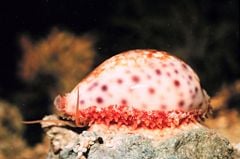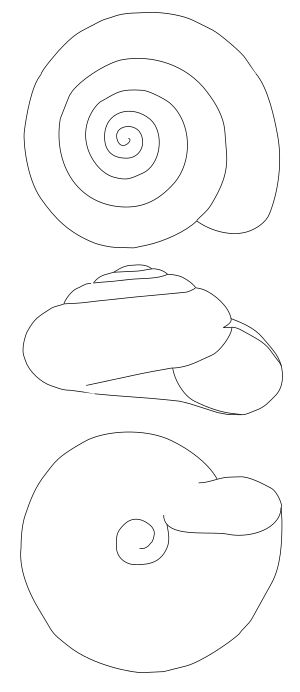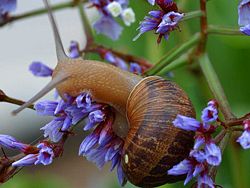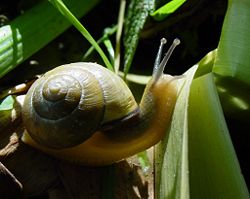Gastropod
| Gastropod | ||||||
|---|---|---|---|---|---|---|
 Cypraea chinensis
| ||||||
| Scientific classification | ||||||
| ||||||
|
Eogastropoda (True Limpets and relatives) |
The gastropods, gasteropods, or univalves, are the largest and most successful class of mollusks, with 60,000-75,000 known living species. This class contains a vast number of marine and freshwater species as well as many terrestrial ones. Species include not only the snails and slugs, but also abalone, limpets, cowries, conch and most of the other animals that produce seashells.
Description
Snails are distinguished by torsion, a process where the body coils to one side during development.
They typically have a well-defined head with two or four sensory tentacles, and a ventral foot, which gives them their name (Greek gaster, stomach, and poda, feet). The eyes that may be present at the tip of the tentacles range from simple ocelli that cannot project an image (simply distinguishing light and dark), to more complex pit and even lens eyes [1]. The larval shell of a gastropod is called a protoconch.
Most members have a shell, which is in one piece and typically coiled or spiraled that usually opens on the right hand side (as viewed with the shell apex pointing upward). Several species have an operculum that operates as a trapdoor to close the shell. This is usually made of a horn like material, but in some molluscs it is calcareous. In some members, the slugs, the shell is reduced or absent, and the body is streamlined so its torsion is relatively inconspicuous.
While the best-known gastropods are terrestrial, more than two thirds of all species live in a marine environment. Marine gastropods include herbivores, detritus feeders, carnivores and a few ciliary feeders, in which the radula is reduced or absent. The radula is usually adapted to the food that a species eats. The simplest gastropods are the limpets and abalones, both herbivores that use their hard radulas to rasp at seaweeds on rocks. Many marine gastropods are burrowers and have siphons or tubes that extend from the mantle and sometimes the shell. These act as snorkels, enabling the animal to continue to draw in a water current containing oxygen and food into their bodies. The siphons are also used to detect prey from a distance. These gastropods breathe with gills, but some freshwater species and almost all terrestric species have developed lungs. While the gastropods with lungs all belong to one group, Pulmonata, the gastropods with gills belong to another, paraphyletic.
Sea slugs are often flamboyantly coloured, either as a warning if they are poisonous or to camouflage them on the corals and seaweeds on which many of the species are found. Their gills are often in a form of feathery plumes on their backs which gives rise to their other name, nudibranchs. Nudibranchs with smooth or warty backs have no visible gill mechanisms and respiration may take place directly through the skin. A few of the sea slugs are herbivores and some are carnivores. Many have distinct dietary preferences and regularly occur in association with certain species.
Geological history
The first gastropods were exclusively marine, with the earliest representatives of the group appearing in the Late Cambrian (Chippewaella, Strepsodiscus). Early Cambrian forms like Helcionella and Scenella are no longer considered gastropods, and the tiny coiled Aldanella of earliest Cambrian time is probably not even a mollusc. By the Ordovician period the gastropods were a varied group present in a range of aquatic habitats. Commonly, fossil gastropods from the rocks of the early Palaeozoic era are too poorly preserved for accurate identification. Still, the Silurian genus Poleumita contains fifteen identified species. Fossil gastropods are less common during the Palaeozoic era than bivalves.
Most of the gastropods of the Palaeozoic era belong to primitive groups, a few of which still survive today. By the Carboniferous period many of the shapes we see in living gastropods can be matched in the fossil record, but despite these similarities in appearance the majority of these older forms are not directly related to living forms. It was during the Mesozoic era that the ancestors of many of the living gastropods evolved.
One of the earliest known terrestrial (land-dwelling) gastropods is Maturipupa which is found in the Coal Measures of the Carboniferous period in Europe, but relatives of the modern land snails are rare before the Cretaceous period when the familiar Helix first appeared.
In rocks of the Mesozoic era gastropods are slightly more common as fossils, their shell often well preserved. Their fossils occur in beds which were deposited in both freshwater and marine environments. The "Purbeck Marble" of the Jurassic period and the "Sussex Marble" of the early Cretaceous period which both occur in southern England are limestones containing the tightly packed remains of the pond snail Viviparus.
Rocks of the Cenozoic era yield very large numbers of gastropod fossils, many of these fossils being closely related to modern living forms. The diversity of the gastropods increased markedly at the beginning of this era, along with that of the bivalves.
Certain trail-like markings preserved in ancient sedimentary rocks are thought to have been made by gastropods crawling over the soft mud and sand. Although these trails are of debatable origin, some of them do resemble the trails made by living gastropods today.
Gastropod fossils may sometimes be confused with ammonites or other shelled cephalopods. An example of this is Bellerophon from the limestones of the Carboniferous period in Europe which may be mistaken for a cephalopod.
Gastropods are one of the groups that record the changes in fauna caused by the advance and retreat of the Ice Sheets during the Pleistocene epoch.
Taxonomy
The taxonomy of the Gastropoda is under constant revision, but more and more of the old taxonomy is being abandoned. Nevertheless terms as "opisthobranch" and "prosobranch" are still being used in a descriptive way. In a sense, we can speak of a taxonomic jungle when we go down to the lower taxonomic levels. The taxonomy of the Gastropoda can be different from author to author. But with the arrival of DNA-sequencing, further revisions of the higher taxonomic levels are to be expected in the near future.
According to the traditional classification there are four subclasses. :
- Prosobranchia (gills in front of the heart).
- Opisthobranchia (gills to the right and behind the heart).
- Gymnomorpha (no shell)
- Pulmonata (with lungs instead of gills)
According to the newest insights (Ponder & Lindberg, 1997), the taxonomy of the Gastropoda should be rewritten in terms of strictly monophyletic groups. Integrating these findings into a working taxonomy will be a true challenge in the coming years. At present, it is impossible to give a classification of the Gastropoda that has consistent ranks and also reflects current usage. Convergent evolution, observed at especially high frequency in the Gastropods, may account for the observed differences between phylogenies obtained from morphological data and more recent studies based on gene sequences.
Proposed classification, down to the level of superfamily
Class Gastropoda (Cuvier, 1797)
Incertæ sedis
- Order Bellerophontida (fossil)
- Order Mimospirina (fossil)
Subclass Eogastropoda (Ponder & Lindberg, 1996) (earlier: Prosobranchia)
- Order Euomphalida de Koninck 1881 (fossil)
- Superfamily Macluritoidea
- Superfamily Euomphaloidea
- Superfamily Platyceratoidea
- Order Patellogastropoda Lindberg, 1986 (true limpets)
- Suborder Patellina Van Ihering, 1876
- Superfamily Patelloidea Rafinesque, 1815
- Suborder Nacellina Lindberg, 1988
- Superfamily Acmaeoidea Carpenter, 1857
- Superfamily Nacelloidea Thiele, 1891
- Suborder Lepetopsina McLean, 1990
- Superfamily Lepetopsoidea McLean, 1990
- Suborder Patellina Van Ihering, 1876
Subclass Orthogastropoda Ponder & Lindberg, 1996 (earlier Prosobranchia, Opisthobranchia)
Incertæ sedis
- Order Murchisoniina Cox & Knight, 1960 (fossil)
- Superfamily Murchisonioidea Koken, 1889
- Superfamily Loxonematoidea Koken, 1889
- Superfamily Lophospiroidea Wenz, 1938
- Superfamily Straparollinoidea
- Grade Subulitoidea Lindström, 1884
Superorder Cocculiniformia Haszprunar, 1987
- Superfamily Cocculinoidea Dall, 1882
- Superfamily Lepetelloidea Dall, 1882 (deep sea limpets)
Superorder ‘Hot Vent Taxa' Ponder & Lindberg, 1997
- Order Neomphaloida Sitnikova & Starobogatov, 1983
- Superfamily Neomphaloidea McLean, 1981 (hydrothermal vents limpets)
- Superfamily Peltospiroidea McLean, 1989
Superorder Vetigastropoda Salvini-Plawen, 1989 (limpets)
- Superfamily Fissurelloidea Fleming, 1822 (keyhole limpets)
- Superfamily Haliotoidea Rafinesque, 1815 (abalones)
- Superfamily Lepetodriloidea McLean, 1988 (hydrothermal vent limpets)
- Superfamily Pleurotomarioidea Swainson, 1840 (slit shells)
- Superfamily Seguenzioidea Verrill, 1884
- Superfamily Trochoidea Rafinesque, 1815 (top shells)
Superorder Neritaemorphi Koken, 1896
- Order Cyrtoneritomorpha (fossil)
- Order Neritopsina Cox & Knight, 1960
- Superfamily Neritoidea Lamarck, 1809
Superorder Caenogastropoda Cox, 1960
- Order Architaenioglossa Haller, 1890
- Superfamily Ampullarioidea J.E. Gray, 1824
- Superfamily Cyclophoroidea J.E. Gray, 1847 (terrestrials)
- Order Sorbeoconcha Ponder & Lindberg, 1997
- Suborder Discopoda P. Fischer, 1884
- Superfamily Campaniloidea Douvillé, 1904
- Superfamily Cerithioidea Férussac, 1822
- Suborder Hypsogastropoda Ponder & Lindberg, 1997
- Infraorder Littorinimorpha Golikov & Starobogatov, 1975
- Superfamily Calyptraeoidea Lamarck, 1809
- Superfamily Capuloidea J. Fleming, 1822
- Superfamily Carinarioidea Blainville, 1818 (formerly called Heteropoda)
- Superfamily Cingulopsoidea Fretter & Patil, 1958
- Superfamily Cypraeoidea Rafinesque, 1815 (cowries)
- Superfamily Ficoidea Meek, 1864
- Superfamily Laubierinoidea Warén & Bouchet, 1990
- Superfamily Littorinoidea (Children), 1834 (periwinkles)
- Superfamily Naticoidea Forbes, 1838 (moon shells)
- Superfamily Rissooidea J.E. Gray, 1847 (Risso shells) (includes genus oncomelania, schistosomiasis transmission vector)
- Superfamily Stromboidea Rafinesque, 1815 (true conchs)
- Superfamily Tonnoidea Suter, 1913
- Superfamily Trivioidea Troschel, 1863
- Superfamily Vanikoroidea J.E. Gray, 1840
- Superfamily Velutinoidea J.E. Gray, 1840
- Superfamily Vermetoidea Rafinesque, 1815 (worm shells)
- Superfamily Xenophoroidea Troschel, 1852 (carrier shells)
- Infraorder Ptenoglossa J.E. Gray, 1853
- Superfamily Eulimoidea Philippi, 1853
- Superfamily Janthinoidea Lamarck, 1812
- Superfamily Triphoroidea J.E. Gray, 1847
- Infraorder Neogastropoda Thiele, 1929
- Superfamily Buccinoidea (whelks, false tritions)
- Superfamily Cancellarioidea Forbes & Hanley, 1851
- Superfamily Conoidea Rafinesque, 1815
- Superfamily Muricoidea Rafinesque, 1815
- Suborder Discopoda P. Fischer, 1884
Superorder Heterobranchia J.E. Gray, 1840
- Order Heterostropha P. Fischer, 1885
- Superfamily Architectonicoidea J.E. Gray, 1840
- Superfamily Nerineoidea Zittel, 1873 (fossil)
- Superfamily Omalogyroidea G.O. Sars, 1878
- Superfamily Pyramidelloidea J.E. Gray, 1840
- Superfamily Rissoelloidea J.E. Gray, 1850
- Superfamily Valvatoidea J.E. Gray, 1840
- Order Opisthobranchia Milne-Edwards, 1848
- Suborder Cephalaspidea P. Fischer, 1883
- Superfamily Acteonoidea D'Orbigny, 1835
- Superfamily Bulloidea Lamarck, 1801
- Superfamily Cylindrobulloidea Thiele, 1931 (has to be included in the Sacoglossa)
- Superfamily Diaphanoidea Odhner, 1914
- Superfamily Haminoeoidea Pilsbry, 1895
- Superfamily Philinoidea J.E. Gray, 1850
- Superfamily Ringiculoidea Philippi, 1853
- Suborder Sacoglossa Von Ihering, 1876
- Superfamily Oxynooidea H. & A. Adams, 1854
- Suborder Anaspidea P. Fischer, 1883 (sea hares)
- Superfamily Akeroidea Pilsbry, 1893
- Superfamily Aplysioidea Lamarck, 1809
- Suborder Notaspidea P. Fischer, 1883
- Superfamily Tylodinoidea J.E. Gray, 1847
- Superfamily Pleurobranchoidea Férussac, 1822
- Suborder Thecosomata Blainville, 1824 (sea butterflies)
- Infraorder Euthecosomata
- Superfamily Limacinoidea
- Superfamily Cavolinioidea
- Infraorder Pseudothecosomata
- Superfamily Peraclidoidea
- Superfamily Cymbulioidea
- Infraorder Euthecosomata
- Suborder Gymnosomata Blainville, 1824 (sea angels)
- Family Clionidae Rafinesque, 1815
- Family Cliopsidae Costa, 1873
- Family Hydromylidae Pruvot-Fol, 1942
- Family Laginiopsidae Pruvot-Fol, 1922
- Family Notobranchaeidae Pelseneer, 1886
- Family Pneumodermatidae Latreille, 1825
- Family Thliptodontidae Kwietniewski, 1910
- Suborder Cephalaspidea P. Fischer, 1883
- Suborder Nudibranchia Blainville, 1814 (nudibranchs)
- Infraorder Anthobranchia Férussac, 1819
- Superfamily Doridoidea Rafinesque, 1815
- Superfamily Doridoxoidea Bergh, 1900
- Superfamily Onchidoridoidea Alder & Hancock, 1845
- Superfamily Polyceroidea Alder & Hancock, 1845
- Infraorder Cladobranchia Willan & Morton, 1984
- Superfamily Dendronotoidea Allman, 1845
- Superfamily Arminoidea Rafinesque, 1814
- Superfamily Metarminoidea Odhner in Franc, 1968
- Superfamily Aeolidioidea J.E. Gray, 1827
- Order Pulmonata Cuvier in Blainville, 1814 (pulmonates)
- Suborder Systellommatophora Pilsbry, 1948
- Superfamily Onchidioidea Rafinesque, 1815
- Superfamily Otinoidea H. & A. Adams, 1855
- Superfamily Rathouisioidea Sarasin, 1889
- Suborder Basommatophora Keferstein in Bronn, 1864 (freshwater pulmonates, pond snails)
- Superfamily Acroloxoidea Thiele, 1931
- Superfamily Amphiboloidea J.E. Gray, 1840
- Superfamily Chilinoidea H. & A. Adams, 1855
- Superfamily Glacidorboidea Ponder, 1986
- Superfamily Lymnaeoidea Rafinesque, 1815
- Superfamily Planorboidea Rafinesque, 1815
- Superfamily Siphonarioidea J.E. Gray, 1840
- Suborder Eupulmonata Haszprunar & Huber, 1990
- Infraorder Acteophila Dall, 1885 (= formerly Archaeopulmonata)
- Superfamily Melampoidea Stimpson, 1851
- Infraorder Trimusculiformes Minichev & Starobogatov, 1975
- Superfamily Trimusculoidea Zilch, 1959
- Infraorder Stylommatophora A. Schmidt, 1856 (land snails)
- Subinfraorder Orthurethra
- Superfamily Achatinelloidea Gulick, 1873
- Superfamily Cochlicopoidea Pilsbry, 1900
- Superfamily Partuloidea Pilsbry, 1900
- Superfamily Pupilloidea Turton, 1831
- Subinfraorder Sigmurethra
- Superfamily Acavoidea Pilsbry, 1895
- Superfamily Achatinoidea Swainson, 1840
- Superfamily Aillyoidea Baker, 1960
- Superfamily Arionoidea J.E. Gray in Turnton, 1840
- Superfamily Buliminoidea Clessin, 1879
- Superfamily Camaenoidea Pilsbry, 1895
- Superfamily Clausilioidea Mörch, 1864
- Superfamily Dyakioidea Gude & Woodward, 1921
- Superfamily Gastrodontoidea Tryon, 1866
- Superfamily Helicoidea Rafinesque, 1815
- Superfamily Helixarionoidea Bourguignat, 1877
- Superfamily Limacoidea Rafinesque, 1815
- Superfamily Oleacinoidea H. & A. Adams, 1855
- Superfamily Orthalicoidea Albers-Martens, 1860
- Superfamily Plectopylidoidea Moellendorf, 1900
- Superfamily Polygyroidea Pilsbry, 1894
- Superfamily Punctoidea Morse, 1864
- Superfamily Rhytidoidea Pilsbry, 1893
- Superfamily Sagdidoidera Pilsbry, 1895
- Superfamily Staffordioidea Thiele, 1931
- Superfamily Streptaxoidea J.E. Gray, 1806
- Superfamily Strophocheiloidea Thiele, 1926
- Superfamily Trigonochlamydoidea Hese, 1882
- Superfamily Zonitoidea Mörch, 1864
- ? Superfamily Athoracophoroidea P. Fischer, 1883 (= Tracheopulmonata)
- ? Superfamily Succineoidea Beck, 1837 (= Heterurethra)
- Suborder Systellommatophora Pilsbry, 1948
Other extant classes of the Mollusca are Bivalvia, Scaphopoda, Aplacophora, Polyplacophora, Monoplacophora and Cephalopoda.
ReferencesISBN links support NWE through referral fees
- ↑ Götting, Klaus-Jürgen (1994). "Schnecken", in Becker, U., Ganter, S., Just, C. & Sauermost, R.: Lexikon der Biologie. Heidelberg: Spektrum Akademischer Verlag. ISBN 3-86025-156-2.
- Paul Jeffery. Suprageneric classification of class GASTROPODA. The Natural History Museum, London, 2001
- Ponder & Lindberg, Towards a phylogeny of gastropod molluscs; an analysis using morphological characters. Zoological Journal of the Linnean Society, 119 83-2651; 1997
External links
- Conchology.be consult over 2,100,000 figured gastropods and other shells
- Taxonomy
- Gastropod Classification compiled by Paul Jeffery
- International Code of Zoological Nomenclature 4th edition, 2000
- Gastropods in captivity
Credits
New World Encyclopedia writers and editors rewrote and completed the Wikipedia article in accordance with New World Encyclopedia standards. This article abides by terms of the Creative Commons CC-by-sa 3.0 License (CC-by-sa), which may be used and disseminated with proper attribution. Credit is due under the terms of this license that can reference both the New World Encyclopedia contributors and the selfless volunteer contributors of the Wikimedia Foundation. To cite this article click here for a list of acceptable citing formats.The history of earlier contributions by wikipedians is accessible to researchers here:
The history of this article since it was imported to New World Encyclopedia:
Note: Some restrictions may apply to use of individual images which are separately licensed.



